WSJ, Sandy, and Global Warming - Asking the Right Questions
Posted on 6 November 2012 by dana1981
The Wall Street Journal (WSJ) has published an opinion editorial (op-ed) regarding Hurricane Sandy, written by Roger Pielke Jr. with a subtitle wrongly claiming that "Connecting energy policy and disasters makes little scientific sense." The basis of that argument follows a very similar line of argument that we previously saw in Pielke Jr.'s obfuscation of the link between extreme weather (including hurricanes) and human-caused global warming.
However, before we get into the op-ed, we will investigate the various related questions that are being asked about the link between Hurricane Sandy and global warming, which happens to be another subject which Pielke Jr. has weighed in on.
It's Global Warming, Stupid
The latest edition of Bloomberg Businessweek has a rather provocative cover:
Pielke Jr. objected to this cover, but is it accurate? The answer depends on exactly what the "it" is that Bloomberg Businessweek is blaming on global warming. This brings us to the various questions that are being asked about the Hurricane Sandy-climate link, all of which have fairly simple, straightforward answers.
1) Did global warming cause Hurricane Sandy? The answer is obviously 'no,' and this is the wrong question to ask. Weather events would of course happen with or without human-caused global warming, but the proper question is not whether global warming was the cause, but what influence it had on the event. The Bloomberg Businessweek article grasps this point, answering the question correctly.
"Would this kind of storm happen without climate change? Yes. Fueled by many factors."
2) Did global warming intensify Hurricane Sandy and its impacts? The answer to this question is a simple 'yes.' Human-caused global warming has caused sea level rise, which increased the hurricane storm surge, leading to more flooding. It has warmed the oceans, fueling the intensity of the hurricane. And it has increased the amount of water vapor in the atmosphere, allowing Sandy to pull in more moisture, causing more rainfall and thus more flooding. Bloomberg Businessweek also answers this question correctly:
"Is storm stronger because of climate change? Yes."
Or as John Cook puts it,
3) Will global warming cause more Sandy-like events in the future? The answer to this question is also 'yes.' Hotter sea surface temperatures - caused by global warming - fuel hurricanes, making them more energetic. While the overall frequency of hurricanes may remain steady or even decrease somewhat, climate scientists expect the frequency of the most powerful hurricanes to increase in a warming world.
Perhaps Pielke Jr. objects to the magazine cover because he assumes it refers to question #1. But upon reading the article itself, the point is correctly made that global warming is increasing the power and/or frequency of extreme weather events like Hurricane Sandy. This point is where the Pielke Jr. WSJ obfuscation comes in.
Extreme Weather Intensity vs. Economic Damage
As in his previous obfuscation, rather than talk about the frequency of intensity of extreme weather events, Pielke Jr. focuses on the economic damage they have caused in the USA over time. He 'normalizes' these costs, accounting for inflation and the growth of population and value in impacted areas, and concludes that some hurricanes in the past caused more normalized economic damage than Sandy appears to have. However, Pielke Jr. does not account for the cost associated with one of the main factors which has prevented rising hurricane damage costs - improved building codes, engineering, and construction. While these improvements may have become a standard adaptation measure, they come at a cost which Pielke Jr. does not account for.
As an analogy, a building constructed to maximize energy efficiency will generally cost more up-front, but those costs may be offset through electricity bill savings. A building constructed to withstand strong winds or low-level flooding will similarly cost more up-front, but will reduce the economic damage caused by the weather events. Pielke Jr. is counting the savings, but not the up-front cost that led to those savings.
Pielke Jr. does note that improved disaster response and weather predictions have played a role in cost mitigation (as an aside, so much for the myth that models are unreliable).
"The relatively low number of casualties caused by Sandy is a testament to the success story that is the U.S. National Weather Service and parallel efforts of those who emphasize preparedness and emergency response in the public and private sectors."
Billions of dollars were also saved because local governments had time to minimize the storm's impact on infrastructure. In short, Pielke's argument is apparently that the normalized costs associated with hurricane damage have remained relatively flat over time because thus far we have been able to adapt with improving technology.
Asking the Wrong Question Again
However, the argument that hurricane damage costs have not increased depends on the choice of baseline for comparison. Perhaps costs associated with extreme weather events have remained relatively steady, but we know human-caused global warming has increased the frequency and/or intensity of many types of extreme weather. We also know that human technology has developed dramatically over the past century.
So, why are we asking about whether normalized hurricane damage costs have increased since a century ago? Why isn't the question whether they've significantly decreased, as one might expect given the fact that we now have much stronger building standards, and that we can now accurately predict a hurricane's path many days in advance? In other words, why should we be satisfied with the same normalized hurricane damage costs as a century ago, as Pielke Jr. seems to be, when people had weaker buildings and little if any warning about incoming hurricanes?
Of course we do not have a second Earth to use as an experimental control study without altering its atmospheric chemistry or increasing its greenhouse effect. However, the fact that normalized hurricane costs have not declined despite major technological advancements suggests that hurricanes have become more powerful, as confirmed in the scientific literature, most recently by Grinsted et al. (2012). Our technological advancements have roughly kept up with the increasing intensity of hurricanes, but compared to the hypothetical control-study Earth, extreme weather damage is almost certainly costing us more money than if we were not causing global warming.
This line of thinking is similar to the myth that reducing CO2 emissions will cost too much money, in which climate contrarians compare the costs of carbon pricing to a world in which climate change does not exist, ignoring the costs of climate change. In the real world, the damage caused by climate change has a real cost which must be accounted for. In the real world, increasing frequency and/or intensity of extreme weather also has a cost, and even if we have managed to prevent those costs from rising, in a world without human-caused climate change they should be falling. Alternatively, adaptation measures like storm barriers and more robust buildings are not free. These represent economic costs which Pielke Jr. does not account for.
This is also the conclusion of a Munich Re technical paper, which finds that the most likely explanation for the discrepancy between increasing extreme weather intensity/frequency and flat normalized economic costs is that:
"...weather-related natural disasters have not become less intensive, but defensive mitigating measures have prevented increasingly frequent weather-related natural disasters from causing an upward trend in normalized natural disaster loss."
And what about a future with even more global warming - will human adaptation be able to keep pace with yet more extreme weather? For example, Lin et al. (2012) found that what was previously once-per-century storm surge flooding in New York City will occur roughly once per decade by the year 2100 as a result of global warming. Just in this one example, how do we adapt to America's largest city - currently home to over 8 million people - being flooded once per decade?
Cherry Hurricanes
In his WSJ op-ed, Pielke Jr. also argues that the USA is "currently in a relative hurricane 'drought.'"
"While it's hardly mentioned in the media, the U.S. is currently in an extended and intense hurricane "drought." The last Category 3 or stronger storm to make landfall was Wilma in 2005. The more than seven years since then is the longest such span in over a century."
It's rather puzzling trying to figure out what point Pielke Jr. is trying to make here, or why he expects the media to make it. In fact there are two glaring cherrypicks in this argument.
First, why are hurricanes unworthy of consideration if they are less than Category 3 when they make landfall in the USA? Hurricane Sandy doesn't even meet this criterion as a Category 1, despite being the largest hurricane with the lowest pressure in the North Atlantic on record, with an estimated $50 billion damage cost. Neither does last year's Hurricane Irene (also Category 1 at US landfall), although it caused $15.6 billion in property damage. In 2008 there was Hurricane Ike, just a Category 2 when it made landfall in the USA, causing nearly $30 billion in damage. None of these are sufficient to end Pielke's "hurricane drought"?
Second, eight years is an awfully short timeframe, and 'no Category 3 storms to make landfall in the USA since 2005' sounds an awful lot like 'no warming since 1998,' another notorious cherrypick.
Additionally, the Accumulated Cyclone Energy (ACE) index of tropical cyclone activity actually indicates that the Atlantic is in a period of high hurricane activity, with 13 of the past 18 years (including 2012) having an above-normal ACE (more than 111% of the 1981-2010 median).
This is also consistent with the NOAA Hurricane Research Division Atlantic hurricane basin re-analysis data (HURDAT), which shows a rising ACE, number of hurricanes, major hurricanes, and named storms in the Atlantic. Thingsbreak plots the HURDAT ACE data with a lowess smooth over a longer timeframe:
As noted above, it's difficult to determine what point Pielke Jr. is trying to make with this cherrypicked argument. If he is suggesting that Atlantic hurricane activity has been low, he is wrong. If Pielke Jr. is suggesting that the USA has simply been lucky not to have been hit by more hurricanes since 2005, well, what's the point of that argument, and why should the media make it?
Emanuel (2005) in showing that hurricane power-dissipation index has increased notes that Pielke Jr. is limiting himself to much less data in only looking at hurricane impacts on land, and Peter Sinclair discusses that human-caused changes in the Arctic are likely to cause the type of blocking events which pushed Hurricane Sandy toward the US coast to occur more frequently. In short, Pielke's argument about good American fortune will likely not last in a changing climate.
Pielke Jr. also repeats one of his previous obfuscations, noting that the IPCC Special Report on Managing the Risks of Extreme Events and Disasters to Advance Climate Change Adaptation (SREX) states that droughts in the Midwest USA have become less frequent, but again fails to mention that the same report predicts that this fortune will not continue.
"There is medium confidence that droughts will intensify in the 21st century in some seasons and areas, due to reduced precipitation and/or increased evapotranspiration. This applies to regions including...central North America".
Pielke's argument here seems to boil down to "the USA has been lucky so far" when it comes to extreme weather impacts, but there is no evidence that this fortune will continue. Quite the opposite, in fact.
The Rest of the World
The USA is also of course not the whole world. As Tamino notes in examining natural catastrophe data published by re-insurer Munich Re, globally the number of weather catastrophes has more than doubled just over the past 30 years. All three types of catastrophes (strorms, floods, and climatological events like heat waves, forest fires, and droughts) have increased by a statistically significant margin over this short timeframe.
"The trends show that catastrophic storms have increased by about 7 per year. Catastrophic floods/mass movement by about 8 per year. Heat/drought/fire catastrophes about 3 per year. That’s an extra 18 catastrophes per year.
18 more catastrophes per year, per year.
What if these trends continue? Then by mid-century, the number of weather-related catastrophes will have nearly doubled again. By century’s end, we’ll have increased from about 300 catastrophes per year in 1980, to over 2400."
Tamino also normalizes the weather catastrophe data - in case the number is increasing due to better reporting instead fo more frequent events - using the Munich Re geophysical catastrophe data (earthquakes, tsunamis, volcanic eruptions). These types of events are less likely to be increasing due to global warming; therefore, any long-term increase may be due to improved reporting. The normalized data also show a rapidly rising trend:
Even from an American-centric view, climate-related catastrophes in other nations impact the global and therefore US economy. Ignoring climate-related disasters happening outside the USA will result in an underestimate of the economic (and human) impact of global warming.
The Real Lesson of Sandy
All of these wrong questions, cherrypicks, and obfuscations lead up to what Pielke Jr. wrongly thinks is the lesson of Hurricane Sandy.
"The only strategies that will help us effectively prepare for future disasters are those that have succeeded in the past: strategic land use, structural protection, and effective forecasts, warnings and evacuations. That is the real lesson of Sandy."
In other words, don't worry about mitigating global warming, let's just see if we can manage to adapt to it.
To be fair, Pielke Jr. does also say "it is indeed important to take action on energy policy." Unfortunately this statement comes immediately after criticizing New York Governor Cuomo and New York City Mayor Bloomberg for correctly noting the link between Sandy's impacts and global warming, and is followed with the claim that "to connect energy policy and disasters makes little scientific or policy sense."
Frankly this statement is ridiculous. Linking energy policy (specifically its associated greenhouse gas emissions) and extreme weather certainly makes scientific sense. As for what makes policy sense, people tend not to act on a threat until they can clearly feel its effects, and the clearest impacts from global warming come in the form of extreme weather events. Scruggs and Benegal (2012) found that extreme weather and public acceptance of global warming are strongly correlated.
"Past and recent public opinion in the US and Europe indicates that beliefs and concerns about climate change are affected in very important ways by short-term economic and weather conditions."
Connecting energy policy and extreme weather therefore makes both scientific and policy sense.
Asking the Wrong Questions, Ignoring the Inconvenient Data
Regarding Hurricane Sandy and global warming, far too many people are asking the wrong question, whether the latter created the former. Of course it did not, but human-caused global warming clearly made the hurricane and its impacts more extreme. It is not only correct, but important to make this point, because public acceptance of global warming is correlated with extreme weather. It is a rare tangible effect of climate change.
While many climate scientists have communicated this concept effectively (e.g. Mann, Trenberth, and Hayhoe), leading to some good journalism on the subject, many others have unfortunately focused too much on what we don't know as opposed to what we do know, which has fed some poor journalism. The poor communication between climate scientists and journalists, and thus between journalists and the public, is one of the main reasons we have not yet achieved serious climate action. While some climate scientists are doing a much better communications job than in the past, others still need to improve and ensure that they are answering the right questions.
The WSJ op-ed is worse yet. It similarly asks the wrong questions, like whether the economic damage from hurricanes has increased instead of asking why it hasn't decreased as a result of improving technology. On top of that, the op-ed ignores inconvenient data like hurricane intensity, ACE, Category 1 and 2 hurricanes making landfall in the USA, technological advancements, projections of increasing drought in the US Midwest, climate-related disasters outside the USA, etc. in order to justify the incorrect conclusions that we should not discuss the clear links between global warming and extreme weather events, and that we should not connect the dots between those events and energy policy.
Our advice to climate experts and policymakers is to read the analysis and advice in the WSJ Pielke Jr. op-ed and then go and do the exact opposite.































 Arguments
Arguments






















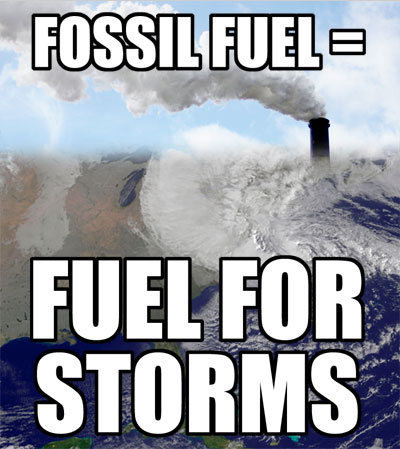

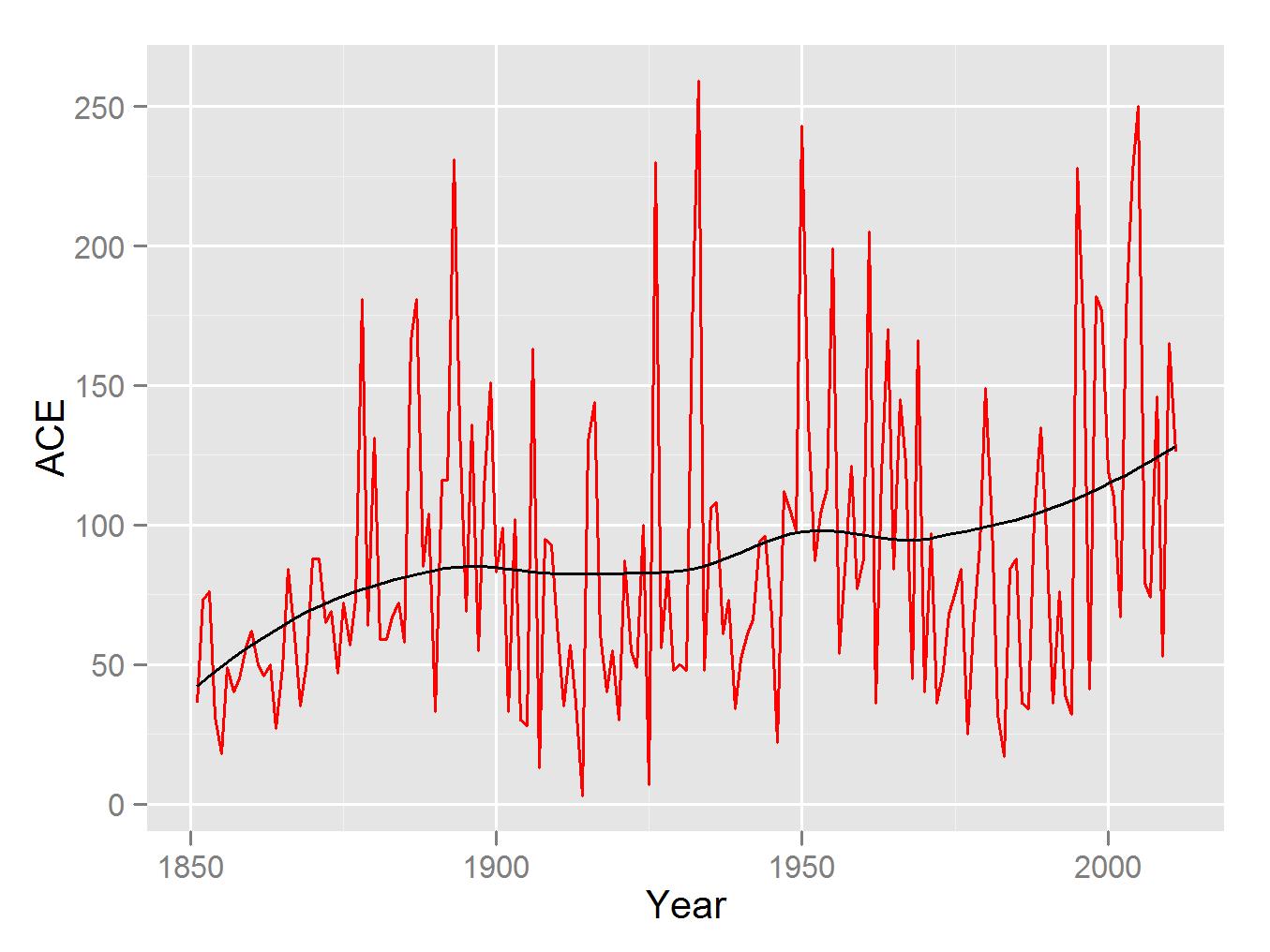
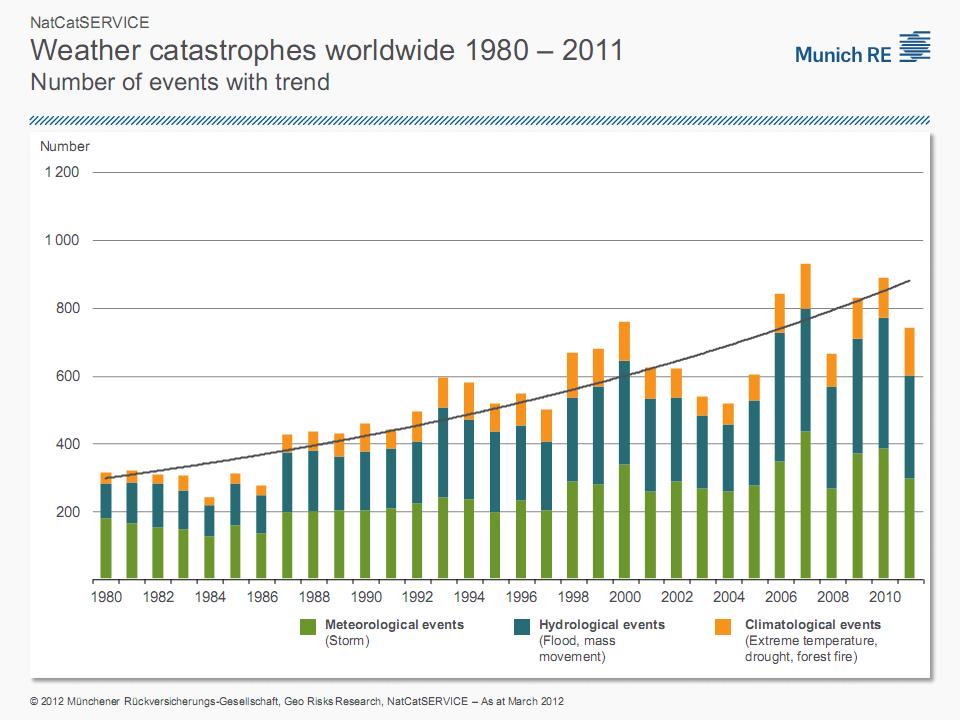
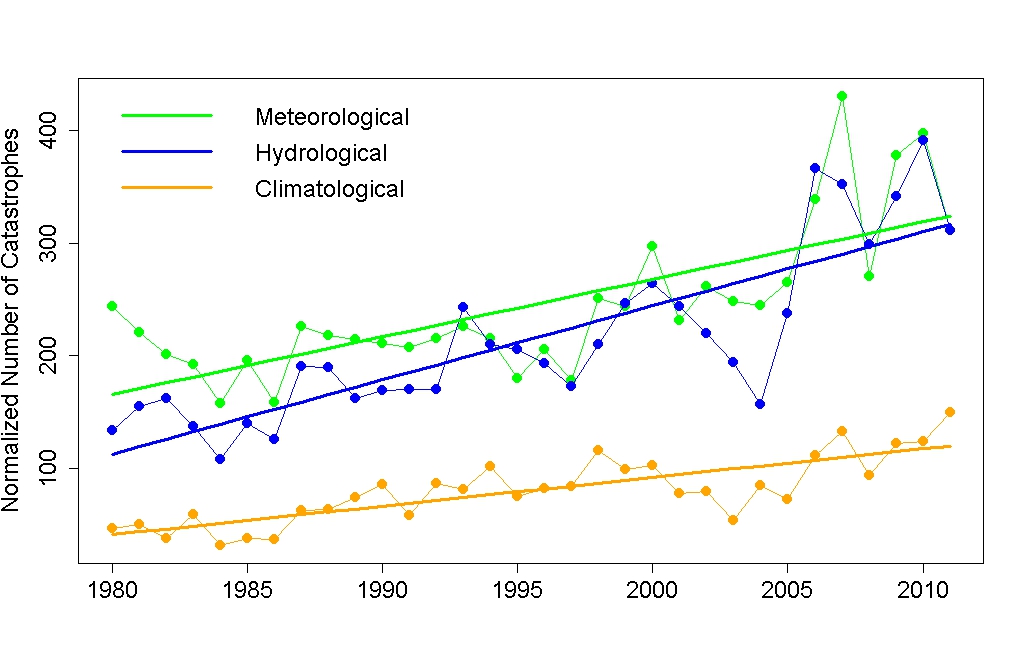


 0
0  0
0



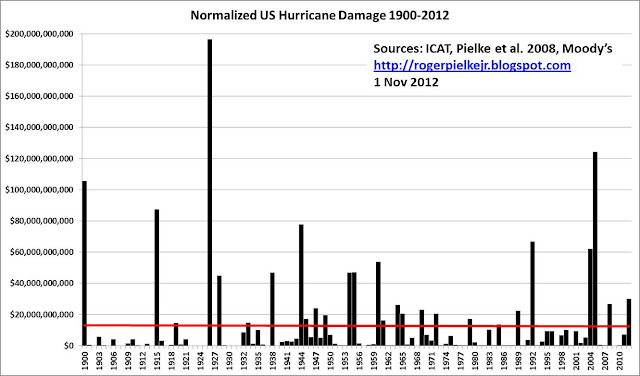 The figures are normalized to 2012 values. Looking at his data for Pielke et al, (2008),he shows only seven land falling hurricanes showing greater than 35 billion dollars damage, normalized to 2005 levels (ie, approx 40 billion normalized to 2012 levels). His claim that Sandy would rank as only the 17th most damaging hurricane is therefore false, assuming Moody's estimates are reasonable.
Oddly, Pielke shows a Sandy estimate of 30 billion, contrary to Moody's, which he cites and links to. Moody's actually gives an estimate of 30-50 billion; from which it appears that Pielke has deliberately reported the low end of the estimated range as being Moody's estimate.
Further, it is illegitimate to quote his "normalized damages" as data for the most costly hurricane. The most damaging hurricane based on his normalized costs was the Great Miami Hurricane of 1926, with normalized losses of 157 billion dollars (normalized to 2005), but the actual cost in 1926 was just 105 million dollars, equivalent to a cost of one billion dollar in constant 2005 value, or 1.15 billion in 2012. Quoting the actual price parity cost is misleading because the increase in costs are largely a consequence of increasing population and wealth; but that does not excuse Pielke's inaccurate language.
What is more, and contrary to Dana, I have severe doubts about Pielke's normalization procedure. As noted, the most highest normalized cost of any land falling Hurricane in the US, according to Pielke is, 157 billion dollars (2005 value). That means normalization has increased the recorded value by nearly 1,500 fold. By contrast, the other two hurricanes making landfall in 1926 have multipliers of 1250 (Hurricane 1, landfall in Florida) and 150 (Hurricane 3, landfall in Louisiana). The second most costly hurricane in Pielke's data was the 1900 hurricane of Galveston ($78,000,000,000; multiplier approx 2,600). That multiplier contrasts starkly with the 160 multiplier of hurricane 4 of 1901.
It is not difficult to recognize the issue involved. Lousiana's population has increased 2.2-fold since 1926, whereas that of Miami has increased more than ten fold in the same period. Galveston is also an area of very high population growth. That population growth has been matched by an increase in land values and in intensive residency. Both population and wealth per capita are factors in Pielke's normalization.
Crucially, however, when cities develop very large populations, construction techniques do not stay constant. Miami, for example has moved from low houses and flats towards large reinforced concrete sky scrapers. The result is a significant loss of vulnerability to storm damage quite independent of any issues related to superior construction techniques for individual housing.
Put simply, dropping a tree on a house destroys it. Doing the same to the Empire State Building will shatter a few panes of glass. You cannot "normalize" the destructive impact of the former relative to the later simply by multiplying costs by the increase in population per square kilometer and the per capita wealth. Such a simplistic approach can only work in regions where the dominant style of construction has remained constant over time, ie, in rural areas and/or small cities and towns.
The crucial point here is that Pielke's flat trend in normalized losses depends on the existence of a very few, very costly (in normalized terms) storms early in the record. Without Galveston 1900, Galveston 1915, Great Miami 1926 and Hurricane 11 1944 (Florida land fall), the trend in normalized damages would undoubtedly be upwards. If Pielke's normalization took proper account of change in building design and standards (demonstrated by Jake above), his data would provide clear evidence that hurricanes are becoming more damaging with increased global temperatures.
The figures are normalized to 2012 values. Looking at his data for Pielke et al, (2008),he shows only seven land falling hurricanes showing greater than 35 billion dollars damage, normalized to 2005 levels (ie, approx 40 billion normalized to 2012 levels). His claim that Sandy would rank as only the 17th most damaging hurricane is therefore false, assuming Moody's estimates are reasonable.
Oddly, Pielke shows a Sandy estimate of 30 billion, contrary to Moody's, which he cites and links to. Moody's actually gives an estimate of 30-50 billion; from which it appears that Pielke has deliberately reported the low end of the estimated range as being Moody's estimate.
Further, it is illegitimate to quote his "normalized damages" as data for the most costly hurricane. The most damaging hurricane based on his normalized costs was the Great Miami Hurricane of 1926, with normalized losses of 157 billion dollars (normalized to 2005), but the actual cost in 1926 was just 105 million dollars, equivalent to a cost of one billion dollar in constant 2005 value, or 1.15 billion in 2012. Quoting the actual price parity cost is misleading because the increase in costs are largely a consequence of increasing population and wealth; but that does not excuse Pielke's inaccurate language.
What is more, and contrary to Dana, I have severe doubts about Pielke's normalization procedure. As noted, the most highest normalized cost of any land falling Hurricane in the US, according to Pielke is, 157 billion dollars (2005 value). That means normalization has increased the recorded value by nearly 1,500 fold. By contrast, the other two hurricanes making landfall in 1926 have multipliers of 1250 (Hurricane 1, landfall in Florida) and 150 (Hurricane 3, landfall in Louisiana). The second most costly hurricane in Pielke's data was the 1900 hurricane of Galveston ($78,000,000,000; multiplier approx 2,600). That multiplier contrasts starkly with the 160 multiplier of hurricane 4 of 1901.
It is not difficult to recognize the issue involved. Lousiana's population has increased 2.2-fold since 1926, whereas that of Miami has increased more than ten fold in the same period. Galveston is also an area of very high population growth. That population growth has been matched by an increase in land values and in intensive residency. Both population and wealth per capita are factors in Pielke's normalization.
Crucially, however, when cities develop very large populations, construction techniques do not stay constant. Miami, for example has moved from low houses and flats towards large reinforced concrete sky scrapers. The result is a significant loss of vulnerability to storm damage quite independent of any issues related to superior construction techniques for individual housing.
Put simply, dropping a tree on a house destroys it. Doing the same to the Empire State Building will shatter a few panes of glass. You cannot "normalize" the destructive impact of the former relative to the later simply by multiplying costs by the increase in population per square kilometer and the per capita wealth. Such a simplistic approach can only work in regions where the dominant style of construction has remained constant over time, ie, in rural areas and/or small cities and towns.
The crucial point here is that Pielke's flat trend in normalized losses depends on the existence of a very few, very costly (in normalized terms) storms early in the record. Without Galveston 1900, Galveston 1915, Great Miami 1926 and Hurricane 11 1944 (Florida land fall), the trend in normalized damages would undoubtedly be upwards. If Pielke's normalization took proper account of change in building design and standards (demonstrated by Jake above), his data would provide clear evidence that hurricanes are becoming more damaging with increased global temperatures.
 The positive trend in strong surge events (and hence hurricanes) is straightforward, as is the increase in US (not North Atlantic) -Accumulated Cyclone Energy.
The positive trend in strong surge events (and hence hurricanes) is straightforward, as is the increase in US (not North Atlantic) -Accumulated Cyclone Energy.







Comments